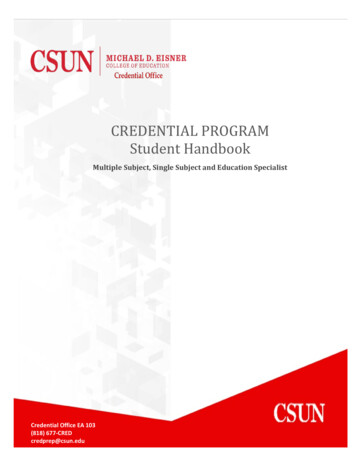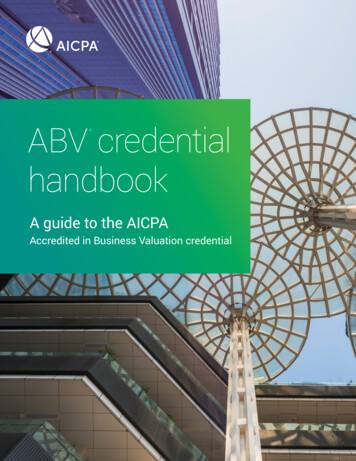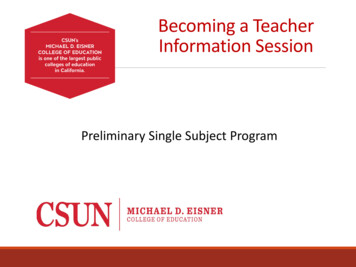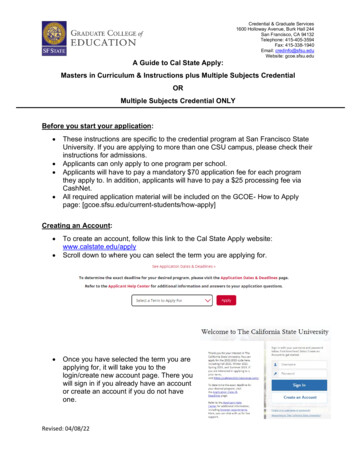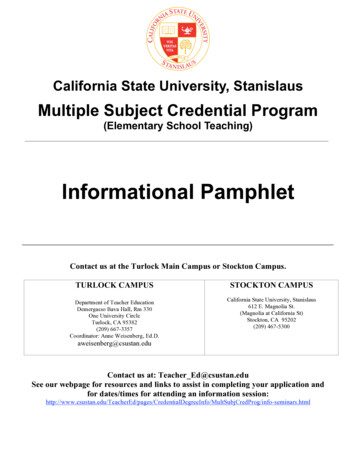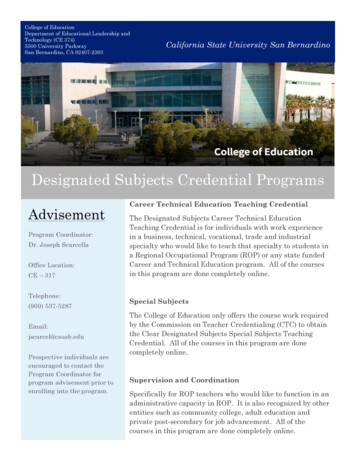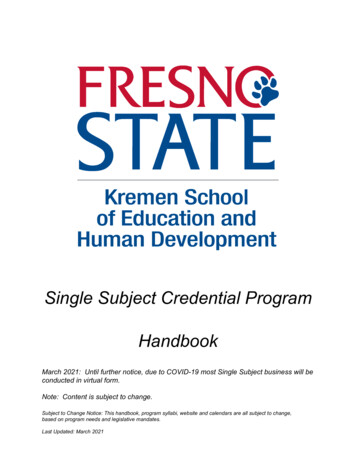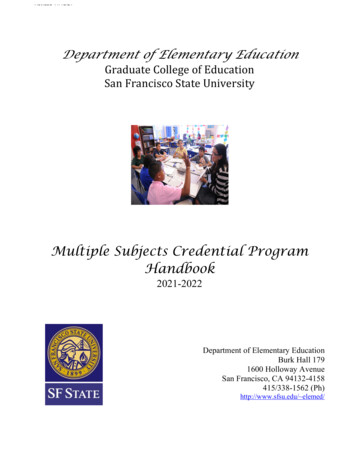
Transcription
Revised 11/18/21Department of Elementary EducationGraduate College of EducationSan Francisco State UniversityMultiple Subjects Credential ProgramHandbook2021-2022Department of Elementary EducationBurk Hall 1791600 Holloway AvenueSan Francisco, CA 94132-4158415/338-1562 (Ph)http://www.sfsu.edu/ elemed/
T A B L E OF C O N T E N T SMessage to the Candidate and TIDES Program3Teacher Certification in California4Multiple Subject Credential Program Options5Course Descriptions10Grading Policy and Successful Academic Progress12Declassification Procedures13Student Teaching Program Structure14Professional Expectations for Cooperating Teachers & Student Teachers16Student Teaching Evaluation Forms19University Supervision Report Form23Teaching Performance Expectations25Appendix A: Preliminary Credential Requirements29Appendix B: U.S. Constitution Requirement30Appendix C: Technology Requirement31Appendix D: CPR Requirement32Appendix E: Adding Credentials33Appendix F: Supplementary/Subject Matter Authorizations34Appendix G: SB 2042 Clear Credential Information35Appendix H: Key Persons and Related Services36Appendix I:37Department of Elementary – Directory2
MESSAGE TO THE CREDENTIAL CANDIDATEWelcome to the SFSU Department of Elementary Education! We are excited to support youthrough your journey to become an effective, engaged, and inspiring teacher who will have a positiveimpact on current and future generations. Although the journey will be challenging at times, there willbe rewards along the way that only you will be able to describe. Earning a teaching credential is acomplex process that requires careful attention throughout this program. This handbook is designed toassist you in completing the Multiple Subject Credential (MSC) program. Knowing the handbook’scontents will help to maximize your experience while informing you about the intricacies of theprogram. It is your responsibility to remain informed and to ask questions when things are unclear.You will need to become familiar with the announcements and regulations of the Universityprinted in the general University Bulletin, the credential courses outlined in this handbook, andimportant notices posted via email and the department’s website. While every effort is made to ensurethe correctness and timeliness of information contained in this handbook, changes do happen, and youwill need to pay attention to all updates that we send out to ensure that you are able to complete thisprogram successfully and within your desired timeline.The faculty and staff members of the Department of Elementary Education congratulate you onyour acceptance to the MSC Program. We wish you all the best!Teaching in Diverse Educational Settings, Multiple Subject Credential ProgramMission Statement from the Department of Elementary EducationThe Department of Elementary Education prepares skilled, transformative educators to teach andbecome leaders in culturally and linguistically diverse schools. We guide and support educators to develop apedagogy of caring and cultural responsiveness, and to teach for social justice and equity for children and theirfamilies. Our Multiple Subject Credential and Master of Arts programs provide current educational theories,innovative teaching practices, and guided field experiences in diverse schools. The curriculum in the MSC andMA graduate programs reflect the Teaching Performance Expectations (TPEs) State Standards and CommonCore Standards. The department’s Multiple Subject Credential, including the Bilingual Authorization Programs,certify candidates with their Preliminary Credential to teach in California schools. Our MA programs prepareeducational leaders to transform learning environments to support all students’ success academically andsocially.Teaching in Diverse Educational Settings (TIDES) Program enables teacher credential candidates todevelop competencies in the following areas: Beginning level mastery of the California Teacher Performance Expectations, the guidelines putforth by the California Commission on Teacher Credentialing. Skills and knowledge needed to teach students who are English language learners or bilingualspeakers by meeting the California Teacher of English Learners Program Standards (CTELformerly CLAD); Development and expansion of dispositions and practices that support educational equity for allchildren; Plans and strategies to support lifelong learning and professional growth3
TEACHER CERTIFICATION IN CALIFORNIAThe Commission on Teacher Credentialing (CTC) governs teacher certification under the authoritygranted to it by the California State Legislature in Senate Bill 2042. SB 2042 includes stipulationsunder Assembly Bill 1059, which authorizes you to teach English Language Learners or what waspreviously designated CLAD and current California Teachers of English Learners (CTEL). Inaddition, if you apply for the Bilingual Authorization it is under the umbrella of the Multiple SubjectCredential. You automatically qualify to teach in general and bilingual classroom settings. This meansthat you will NOT have to complete a separate (or an additional) CLAD program nor take the CTELexams. CTC accredits the Multiple Subject Credential Program and Bilingual Authorization at SanFrancisco State.*In other words, when you are asked on job applications if you have CLAD certification, the answer isyes!There are two phases of credentialing in California:Preliminary CredentialThe initial issuance is a Preliminary Credential, valid for five years. This is the certification you willreceive upon completion of the SFSU Multiple Subject Program all additional preliminary credentialrequirements. Please review Appendix A to be sure you are on track to complete ALL preliminaryrequirements.In applying to the MSC program, pre-requisites are: Bachelor’s Degree posted on transcripts California Subject Examinations for Teachers (CSET-Multiple Subject Tests 1, 2, 3) Basic Skills Requirement (CBEST or the CSET Subtest IV -Writing) Certificate of Clearance – COC (Fingerprint Clearance) Verification of completing 45 hours of Early Field Experience in a public school.While in the MSC program, requirements and completion include the following: Submission & passage of the Educational Teacher Performance Assessment (edTPA). Enrolling and passing Level I Technology –ITEC 711 (3units). Proof of U.S. Constitution course or exam (Note: CSU graduates meet this requirement.) Cardio-Pulmonary Resuscitation (CPR) Certification, Reading Instruction Competence Assessment (RICA) Exam.Clear CredentialThe process of “clearing” the preliminary credential is the employing district’s responsibility.Your district will require you to participate in a two-year Induction Program. You have five years inwhich to “clear your preliminary credential.” If you do not clear your credential or if you becomeemployed by a district or private school that doesn’t have an Induction Program, there are otheralternatives. Please look to your employment site and/or CTC for information. See Appendix G: SB2042 Clear Credential Information.4
Multiple Subject Credential (MSC) Program OptionsThe Multiple Subject Credential Program (MSC) offers multiple pathways to the preliminarycredential. The coursework for candidates is the same regardless of your program choice.The pathways are: one year summer start or three-semesters pathwaybilingual authorization credential – Cantonese, Mandarin or Spanish;internship individual planIn all but the individualized pathways, candidates are assigned to a cohort and progress through theMSC program together. Those candidates who are on an internship credential will receive intensiveadvising and typically join various cohorts as they progress through the program.MSC Bilingual Authorization ProgramsBilingual authorization is designed for candidates who have a high level of proficiency in Cantonese,Mandarin or Spanish and who plan to teach in bilingual classrooms. Candidates must declare theircandidacy for bilingual authorization on the program application. Students who complete the SFSUbilingual authorization program and supplemental coursework, EED 713 (Spanish) or EED 711 ANDEED 712 (Chinese), do not need to take the CSET: LOTE language examination (Subtest III).5
One Year Summer StartMultiple Subject Credential ProgramThe one year program provides an intensive teacher education experience that prepares graduates torapidly take on the full responsibilities of classroom teaching. The program begins in July with twopreparatory courses and continues for two full time semesters. Features of this pathway include: Full time schedule with primarily daytime hours, well suited for students who need a schedulethat matches school hours Two student teaching placements (Fall and Spring) to prepare students for the range of gradelevels for which they may be hired Coursework that is integrated into practicum placements to support application of universitylearning to classroom teaching practice Cohort model to provide academic and social support Option to continue toward MA degree after credential, while working full time as a teacherOne Year Summer Start Completion PathwayCoursesSummerEED 756 PracticumSeminar 1EED 701 Foundations ofEducationFallEED 786 Seminar inLearning andDevelopmentEED 782 TeachingReading and LanguageArtsSpringEED 777* C&I ScienceEED 737* Social Studies,Social Justice, and LiteracyEED 758 Practicum Seminar3EED 784 C&I MathFieldworkITEC 711 Technology inElementary SchoolsEED 746 (4 units)EED 748 (6 units)15 hours/ week4 days/ week for 16 weeks2.5days(January start)*EED 777 and EED 737 are taught as intensive, hybrid learning modules. Students spend one fullweek immersed in content and pedagogy, supplemented by online sessions and practicum-basedassignments.Special Financial Aid Information for One Year Program ApplicantsStudents who wish to follow the one year completion pathway must apply for Summer admissions.Students who are interested in applying for financial aid assistance for the summer term must completethe current year’s FAFSA (Free Application for Federal Student Aid). For example, if you areadmitted for the Summer 2020 term, you must complete the 2019-2020 FAFSA application. If you areinterested in financial aid assistance for the subsequent fall and spring terms, you must complete theupcoming year’s FAFSA (2020-2021 aid year). Both applications can be accessed at www.fafsa.gov6
Three SemesterMultiple Subject Credential ProgramThe three semester SFSU Multiple Subject Credential Program provides comprehensive preparation forgraduates to become highly effective teachers across a range of elementary grade classrooms (typicallygrades Tk-6). Features of this pathway include: Student teaching placements across every semester of enrollment that gradually build towardfull responsibility for classroom instruction Coursework that is integrated into practicum placements to support application of universitylearning to classroom teaching practice Cohort model to provide academic and social support Option to integrate MA degree requirements concurrently with credential coursework ORcompletion of MA degree after credential, while working as a full time teacherSample Completion PathwayExact order of some classes will vary by cohortCoursesSemester 1EED 756 PracticumSeminar 1Semester 2Semester 3EED 786 Seminar inEED 758 PracticumLearning and Development Seminar 3EED 701 Foundations of EED 784 C&I MathEducationEED 737 Social Studies,EED 782 TeachingSocial Justice, and LiteracyReading and LanguageArtsITEC 711 Technology inElementary SchoolsEED 777 C&I ScienceFieldwork EED 687 (3 units)EED 747 (3 units)EED 748 (4 units)12 hrs/ week12 hrs/ week4 days/ weekMA*1 MA class if admitted to1 MA class if admitted to(optional)MA pathwayMA pathwayStudents who choose to begin MA coursework concurrently will complete the four remaining MAclasses after the credential program. These can be completed while working full time as a teacher.7
Spanish Bilingual Educators for Social Transformation (BEST)Multiple Subject Credential Spanish Bilingual Authorization ProgramProgram OverviewBEST embraces concepts of social justice and equity with a focused philosophical stance representingcritical pedagogy and rooted in bilingual education. BEST integrates culturally relevant pedagogythroughout the three-semester course sequence. The program aims to support the development ofcritical educators who are equipped with resources to analyze why many immigrant communities andlater generations have struggled to obtain social and economic equity within the U.S.Teachers with bilingual authorization are in high demand in local school districts. Candidates have theopportunity to complete their field experiences in a variety of bilingual elementary settings in order todevelop competencies that support students attending schools with diverse bilingual program models.Sample Completion PathwayExact order of some classes will vary by cohortCoursesSemester 1Semester 2Semester 3EED 713 Spanish Heritage EED 786 Seminar inEED 758 PracticumLanguage and PedagogyLearning andSeminar 3DevelopmentEED 756 Practicum Seminar1EED 784 C&IMath (Spanish andEED 701 Foundations ofEnglish)EducationEED 737 Social Studies,EED 782 Teaching Reading Social Justice, andand Language Arts (Spanish Literacyand English)EED 777 C&I ScienceITEC 711 Technology inElementary SchoolsEED 747 (3 units)EED 748 (4 units)Fieldwork EED 687 (3 units)12 hrs/ week12 hrs/ week4 days/ weekStudents may choose to continue toward MA degree after completion of credential coursework.MA degree may be completed while working full time as a teacher.8
CHINESE BILINGUALTHREE SEMESTER COURSEWORKFALL SEMESTEREED 701: Social, Cultural, Historical Foundations on Education3 unitsEED 712: Chinese Literacy, TK-63 unitsEED 737: Social Studies, Social Justice and Literacy3 unitsEED 756 Seminar Student Teaching3 unitsEED 687: Student Teaching3 unitsITEC 7113 units* ITEC 711 is in the Department of ELSIT. The course can be taken anytime during the credential program.We strongly recommend enrolling during your first semester.SPRING SEMESTEREED 711: Chinese Heritage3 unitsEED 784: Curriculum and Instruction in Mathematics3 unitsEED 777: Curriculum and Instruction in ScienceEED 782: Teaching English Reading/Language Arts K-53 units3 unitsEED 786: Seminar in Developmental Teaching and Learning3 unitsEED 747: Teaching Practicum Phase II3 unitsFALL SEMESTEREED 758: Teaching Practicum Seminar3 unitsEED 748: Teaching Practicum Phase III4 units9
DESCRIPTIONS of REQUIRED COURSES - Preliminary CredentialEED 701: Social, Cultural, Historical Foundations of Education3 unitsExamines, from a critical perspective, historical, social, and cultural foundations for theoreticalframeworks and pedagogical practices for the classroom. Development of a critical perspective isemphasized.EED 782: Teaching Reading/Language Arts, grades K-33 unitsResearch-based teaching practices for early literacy development. Systematic and explicit instruction inteaching a comprehensive literacy curriculum in grades K-3 that includes: oral language development,basic reading skills, strategic reading behavior, language arts skills, vocabulary and writingdevelopment.EED 784: Curriculum and Instruction in Mathematics3 unitsExplores methods and materials for teaching mathematics to linguistically and culturally diverseelementary school students. Review of mathematics curriculum, classroom organization, assessment,and guided experiences in teaching mathematics.EED 777: Curriculum and Instruction in Science3 unitsPlanning, developing, teaching, and evaluating learning experiences in science. Foci for teachingelementary school science will be on scientific literacy, reflective practice, and equity. In-classactivities and course projects are organized: to provide opportunities to develop and teach inquirybased science lessons; to demonstrate understanding of the nature of science, science teaching &learning; and to assess student (and teacher) progress in science learning (and teaching).EED 737: Teaching Social Studies, Social Justice and Literacy, grades 3-63 unitsFrameworks and methods for implementing integrated curricular in elementary school, focusing onsocial studies content and social justice perspective. Instruction of effective expository literacystrategies.EED 786: Developing Teaching and Learning3 unitsA theory and research based examination of cognitive, social-emotional, ethical, and physicaldevelopment of all children within sociocultural contexts. We will examine the interrelated impacts ofculture, family, community, and school on development. We will examine educational research andconsider its applications in practice to learn how to create positive and productive learningenvironments for all students. The course addresses inclusion through Universal Learning Design(UDL) and Multi-Tiered Structure Systems (MTSS).EED 711: Chinese Heritage Language and Pedagogy (Chinese Bilingual only) 3 unitsTo continue the advancement of the Chinese proficiency for the MS bilingual credential candidates inspeaking, reading, writing, listening, and culture development. Candidates learn pedagogical strategiesto teach bilingual Chinese and second language learners in elementary classroom settings. It preparescandidates to become reflective practitioners with a focus on linguistic issues.EED 712: Teaching Reading and Language Arts, Chinese Bilingual3 unitsThis course prepares elementary school teacher candidates with theories and research findings to teachreading and language arts in Chinese. Systematic and explicit instruction in teaching a comprehensiveChinese literacy includes: oral language, reading strategies, vocabulary and writing development.EED 713: Spanish Heritage Language and Pedagogy3 unitsSpanish Heritage Language for the Bilingual Teacher CandidatesTo continue the advancement of the Spanish proficiency for the MS bilingual credential candidates inspeaking, reading, writing, listening, and culture development. Candidates learn pedagogical strategies to teachbilingual Latino and second language learners in elementary classroom settings. It prepares candidates tobecome reflective practitioners with a focus on linguistic issues. It addresses the vast linguistic and culturaldiversity of Latinos in the USA.10
EED 687: Teaching Practicum I (Three semester program)3 unitsUnderstanding school and classroom culture, roles of the teacher in contemporary urban schoolsettings, instruction, teaching, evaluation, professional responsibilities and opportunities, andcommunity relationships. Application of theory to practice. CR/NC grade only.EED 746: Teaching Practicum I (One-year program)3 unitsThis is the first of two phases of developmental field experiences in a public elementary school under theguidance of a Supervising Teacher and University Supervisor. Teaching is planned and practiced at thebeginning level based on California State standards. CR/NC grading only.EED 756: Teaching Practicum Seminar I (Three semester program only)3 unitsSupports development of candidate’s skills in classroom management, building community, planning,teaching, and assessing all students across the elementary school curriculum. An introduction into theIndividualized Education Plan (IEP), how to access curriculum and support to students with learning needs.CR/NC grade only.EED 747: Teaching Practicum II (Three semester program)3 unitsThis is the second semester field experience in a public elementary school under the guidance of aSupervising Teacher and University Supervisor. The multiple roles of teaching are planned, practicedand assessed at this Phase II level. CR/NC grade only.EED 748: Teaching Practicum III (One–year – 7 units)4 unitsThis is full time student teaching in the final semester at a public elementary school under the guidanceof a Supervising Teacher and University Supervisor. Four a week for the entire semester, includingsolo teaching. CR/NC grade only. Students in the one-year program will teach four and a half days.The one half-day is in order to attend student teaching seminar.EED 758: Teaching Practicum Seminar III3 unitsThis is the final student teaching seminar. Emphasis is on full-time student teaching responsibilities,professional ethics and legal responsibilities. This seminar guides candidates through the TeacherPerformance Assessment (edTPA). CR/NC grade.ITEC 711: Instructional Computing in Elementary and Middle SchoolsStudents are introduced to concepts that are core to safe and informed practices of using digital mediasuch as digital citizenship, digital literacy, internet safety, encryption, analytics, GPS tracking etc.Students are introduced to the various issues and troubleshooting strategies to address while using thedevices. This is a hands-on course, where students learn to use a variety of digital applications to createinteractive digital learning material, including computational thinking with Excel, Info-graphics withgraphics editor, communication and collaboration with blogging tools, digital storytelling with videoediting software, classroom website development with Google products, virtual trips using 3-D virtualreality products.11
GRADING POLICYCandidates must maintain a “B” average in coursework each semester. Any grade of a C or C willautomatically lower your GPA and result in probationary status because these are graduate levelcourses.You cannot receive a grade lower than a “C.” In the event that a candidate receives a grade of “C-” orbelow, he/she must retake the course with the approval of the department chair; this opportunity is on aone-time only basis. Likewise, candidates who receive a grade of “NC” in a practicum or seminar needthe chair’s approval to repeat the practicum or seminar, also on a one-time only basis. If you areexperiencing difficulties with courses and/or seminars, see the appropriate instructor and Dept.Chair to problem solve. Do not avoid this professional responsibility.Requests for a grade of “Incomplete” are greatly discouraged. Once the program is underway, it isextremely difficult for a candidate to make-up work. In the event that an Incomplete is underconsideration, the instructor will bring it to the department chair’s attention. Together they will comeup with a plan to help the candidate complete outstanding work.If you are experiencing difficulties in your field assignment please contact your university fieldsupervisor. It is critical that you first communicate with your Master Teacher, if necessary with youruniversity supervisor, and if the issue is not resolved, with the Department Chair Dr. Josie Arce or Ms.Diane Garfield, Placement Coordinator.SUCCESSFUL ACADEMIC PROGRESS REQUIREMENTSIf a credential candidate demonstrates academic challenges (problems with coursework, grades of C orlower and/or not maintaining the required GPA 3.0), student teaching problems (EED 687, 747,748),and/or professional challenges (inappropriate actions/behaviors in either academics or studentteaching) the candidate will be required to meet first with specific professor/s and EED Dept. Chair.The following is the protocol procedure.1. Faculty will alert a candidate who is demonstrating risk in receiving lower grades or notmeeting course expectations. Communication may initially be via email, then face-to-faceconference to review academic performance before or by mid-semester.2. Student Teaching Practicum depends on the observations and feedback from Master Teachersand university field supervisor. If one or both report areas of concern they will first conferencewith the candidate. If there is limited or no improvement then these supervisors have theresponsibility to report to the Department Chair (Dr. Mina Kim, [minakim@sfsu.edu].Placement issues and basic understanding of student teaching responsibilities and expectationsshould be communicated to Ms. Diane Garfield, Field Placement Coordinator[diangarf@sfsu.edu].3. Faculty member confers with the candidate and identifies a plan to address ways to improve.Faculty member will document the agreed-upon plan and provide a copy to the candidate. Boththe faculty member and the candidate are responsible for following through with the plan.4. If difficulties continue, the faculty member will consult with the Department Chair regardingthe declassification process.Note: As previously stated, grades of “incomplete” are not encouraged. In addition, candidates will notbe allowed to start coursework and/or fieldwork without rectifying any low grades or incompletes twoweeks prior to the start of the following semester. If candidates do not move from probationary statuswithin the following semester you will be asked to withdraw or declassification procedures will begin.12
DECLASSIFICATIONDeclassification is a serious matter and credential candidates should familiarize themselves with theprocess. To be declassified means you cannot continue in the program, nor in any of the programs inthe GCOE. You can reapply to another college. Please read carefully.1. Candidates may be declassified from the Multiple Subject Credential Program for any of thefollowing reasons:a. Unsatisfactory academic performance (grade of "NC” (no credit) or grade lower than a "C") atthe completion of any required course or a combination of courses and field practicum;b. Unsatisfactory or unprofessional performance during field placement or in your courses;c. A grade point average of less than 3.0 reflecting limited or not improving after being placed onthe first academic probation semester while in the program;2. Field site personnel and/or SF State EED faculty may initiate concerns by submitting to theDepartment Chair a written communication about candidate’s fieldwork or academic course work.Evidence to support concerns such as lesson observations, Master Teacher communication, and studentto faculty communication and/or course assignments will be included.3. The candidate meets with the Chair to review the specific concerns. A second meeting is scheduledwith the presence of the specific Faculty, University Supervisor, Master Teacher, and/or StudentPlacement Coordinator. The Dept. Chair based on reviewing the frequency of incidents or academicstanding or a combination of reasons will either design a plan for remedies within a specific timeline ordecide to submit a letter and evidence to recommend declassification to the Dean of Graduate Studies.The Dean of Graduate Studies determines the decision.4. If there is very limited improvement or no improvement where the evidence demonstrates that thecandidate is not meeting our professional or academic standards of the Multiple Subject CredentialProgram and CTC Teacher Performance Expectations, the Department Chair with consultation ofspecific faculty will proceed with submitting a letter and documentation of the evidence to the SFSUDean of Graduate Studies to request a review for declassification from the MSC Program.Documentation of evidence will be sent to the Graduated Studies. The Dean of Graduate Studies makesthe final decision.5. The Dean of Graduate Studies contacts the student. Declassification means that you will bewithdrawn from the Multiple Subject Credential Program Dept. of Elementary Education. You will notbe permitted to enroll as a matriculated student or in any other student status in the Department ofElementary Education. You can formally apply to another program.13
STUDENT TEACHING STRUCTURECandidates will complete more than 600 hours of clinical practice/ student teaching during their time inthe Multiple Subject Credential Program. This gives candidates extended opportunities to learn fromexperienced teacher mentors (“Cooperating Teachers”) and to practice their growing skills asprofessional educators.In each placement, student teachers will receive ongoing feedback from supervisors and courseinstructors. Student teachers will receive feedback a minimum of six times in each placement, througha combination of in person visits and course-based video feedback.Student Teaching Structure for Three Semester Pathways(including Bilingual Authorization Candidates)Phase I: EED 687The student teacher will be in the classroom for 12 hours a week for a minimum of 15 weeks. This isusually two full days per week, but alternate schedules may be needed to maximize participation ininstructional time. The student and cooperating teacher will develop a mutually agreeable schedule.In Phase I, university supervision will occur via video feedback, on campus meetings with 687instructor, and practice-based assignments in coursework that allow the instructor to view teachingpractice via video and provide feedback on planning, instruction, and assessment. The student teacherwill also receive mid-term and final evaluations from the cooperating teacher.Successful completion of Phase I will be determined by the EED 687 instructor in consultation with thecooperating teacher and course instructors who have provided teaching feedback.Phase II: EED 747As with Phase I, the student teacher will be in the classroom for 12 hours a week for a minimum of 15weeks. This is usually two full days per week, but alternate schedules may be needed to maximizeparticipation in instructional time. The student and cooperating teacher will develop a mutuallyagreeable schedule.Phase III: EED 748Student teachers will be in their full-time student teaching semester, working in the classroom for fourdays a week, all day. Student teachers are expected to be available before and after the school day inaccordance with their host school’s expectations for teachers. During this student teaching semester,the student is expected to regularly take responsibility for whole class instruction and will be requiredto teach a minimum of five non-consecutive solo days, and five consecutive solo days.AssessmentStudents in Phases
San Francisco State University Multiple Subjects Credential Program Handbook 2021-2022 Department of Elementary Education Burk Hall 179 1600 Holloway Avenue . receive upon completion of the SFSU Multiple Subject Program all additional preliminary credential requirements. Please review Appendix A to be sure you are on track to complete ALL .

